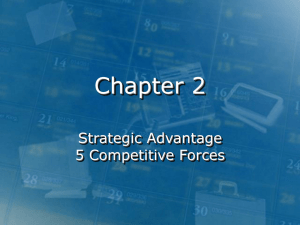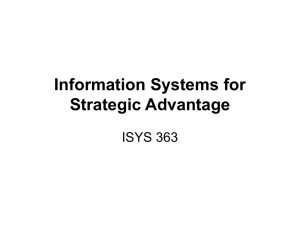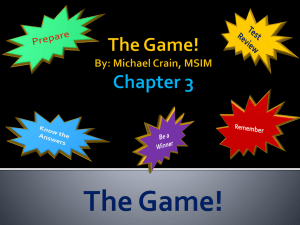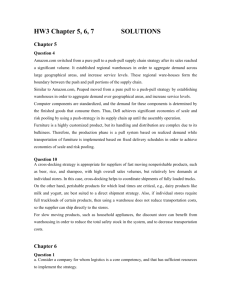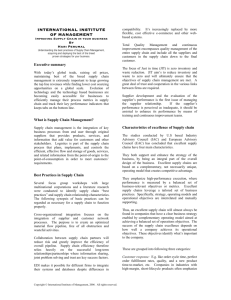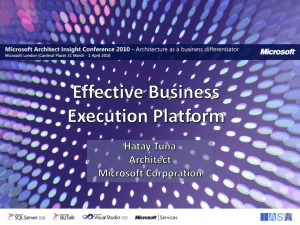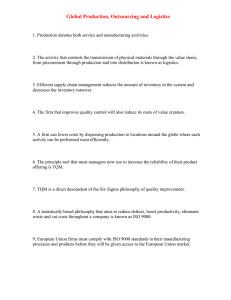Strategies
advertisement
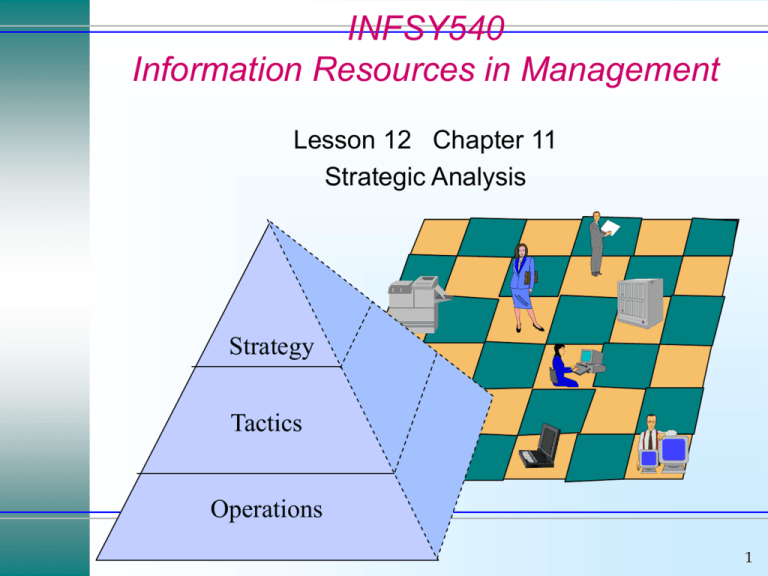
INFSY540 Information Resources in Management Lesson 12 Chapter 11 Strategic Analysis Strategy Tactics Operations 1 Outline Operations, Tactics, Strategy and Change The Competitive Environment External Agents Methods to Gain Competitive Advantage How IS can help The Search for Innovation Customers Suppliers Rivals (new entrants. Substitute products) Government Regulations How IS can help Costs and Dangers of Strategies How IS can hurt 2 Lewin’s model for organizational change •Organizations must be able to change as their environment changes. •Change can happen at any level: Operational, Tactical, Strategic •Change can be incremental (continuous improvement, TQM) or sweeping (business process reengineering) 3 Strategies Competitors Suppliers Company Customers 4 Porter’s Five Forces Model Threat of New Entrants Bargaining Power of Suppliers Rivalry Among Existing Competitors Bargaining Power of Buyers Threat of Substitute Products or Services 5 Methods to Gain Competitive Advantage Barriers to Entry Prevent others from entering the industry. Movie distribution Consumers incur learning and data transfer costs. Baxter Healthcare Add new features or create new products with IT. Federal Express & Merrill Lynch Quality Management IS to cut costs. Wal-Mart Product Differentiation Switching Costs Lower Production Costs Distribution Channels Additional costs of creating an information system. People’s Express Monitoring production lines and analyzing data. Digital Equipment Corp. Value Chain Expanding forward or back the value chain to find greater profits. Boeing Information Systems 6 Developing Strategies Corporate Strategy Development monitor rivals • expectations • strengths • goals • weaknesses • rivalry • opportunities • critical success factors Market Measures - Market share - Concentration - Growth - Profitability Performance Measures - ROA - ROI - EPS - Growth - Subjective Business Strategies and Priorities Process Changes Data Needs IS Changes - Cost leadership - Differentiation - Innovation - Linkages - Re-engineering - Organization - Decentralization System Development & Implementation Business Operations & Rules Existing Data and IS 7 Search for Innovation Research Analysis & modeling, project management, work group support, databases, decision support. Manufacturing Engineering & Design CAD/CAM, testing, networks, work group support. Mass customization, links to customers & suppliers, quality monitoring, expert systems for maintenance, production databases, business integration. Logistics & Supply Just-in-time linkages, forecasts, models, links for design, transaction processing. 8 Search for Innovation Marketing Frequent buyer database, target market & media analysis, survey design and analysis, multimedia promotion design, links to customers and designers. Service Management Sales & Orders Portable computers for sales, ES for order customization, work group tools for customer support. Phone support, GIS locators, scheduling, ES diagnostics, databases. EIS, e-mail, bulletin boards, decision support systems, personal productivity tools, work group support Links to service providers Accountants Consultants Lawyers, . . . 9 Dangers 10 Conclusions 11 Dangers: Capital Cost Money for research Money for information technology 12 Danger: Competition Follows IS Costs You Time Transaction Processing Network & link sales people Experimental technology & global links IS Costs Rival Time Network & DSS Link to suppliers & customers 13 Danger: Changing Industry & Government Intervention New technology New services Customer Customer Customer Industry 1 (expands into industry 2) Customer Customer Industry 2 (new competitor) Same technology Customer Customer Customer 14 Need to control access. Need to worry about network interceptions and hackers. Danger: Security Production Firm Hackers or competitors Security firewall Data we wish to share. Data we want to protect. Customer 15 Conclusions? IT can help achieve strategic competitive advantage. Use of IS to add value is strongly influenced by organizational structure, culture and change. Oftentimes, IT is a smokescreen for the action that provides the real strategic competitive advantage. IS can provide more value than just cost cutting Strategic gains based on IT solutions are often fleeting and require continual improvements. Others... 16 Questions about Strategic Analysis ? 17 Questions to Consider How do companies compete? What are the ways to achieve competitive advantage? How can IT be used to help achieve competitive advantage? What are the costs and risks of using these methods? 18 Methods to Gain Competitive Advantage Barrier To Entry Supplier Supplier Supplier Ties To Suppliers Decreased Costs Firm Control Of Distribution Improved Quality Rival Wholesale Ties To Customers Innovation and Differentiation Consumer Consumer Consumer Increased Switching Costs Consumer Consumer Consumer Consumer 19 Barriers to Entry Economies of Scale (size) Economies of Scope (breadth) Product Differentiation Capital requirements Cost Disadvantages (independent of size) Distribution Channel Access Government Policy 20 Value Chain Firm Infrastructure Human Resources Management Technology Development Procurement Inbound Logistics Operations Outbound Marketing Logistics & Sales Service 21 Process Innovation Suppliers Production Logistics/ Supply Research Engineering and Design Management Manufacturing Marketing Customer Service Sales and Order Management Customers 22 Research Analysis and models Statistical analysis of data Project management and budgeting Work-group collaboration and communication 23 Engineering and Design CAD/CAM Integrated design database Production databases and model testing Expert Systems for manufacturability Work group communication 24 Manufacturing Links to customers Links to suppliers Mass customization Robotics Diagnostic Expert Systems Quality monitoring and control 25 Logistics and Supply Just-In-Time Inventory and EDI Configuration and design Searching for availability, pricing, . . . networks 26 Marketing Frequent buyer databases Point-of-Sale and trends Statistical analysis of data Geographic Information Systems Links to external marketing agencies Multimedia development of promotions 27 Sales and Orders Sales force automation, hand-held computers Customer workstation access Expert Systems for product and option selection Expert Systems for configuration and shipping Front-line support: ES, e-mail, work groups 28 Service Portable computers for service anywhere Databases (e.g., customer service) Location monitoring of service personnel Product internal, automatic diagnostics Expert System diagnostic tools 29 Management Executive Information Systems Simulation (and rivalry games) Links to external partners (accounting, law, . . .) Electronic conferencing Work group communication, e-mail Standardization, Modularization, Franchises Knowledge Workers Client-server instead of hierarchical computing 30
